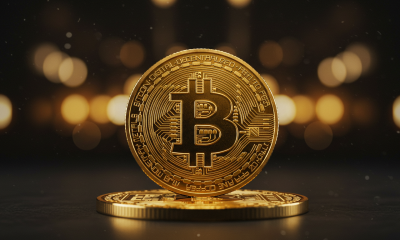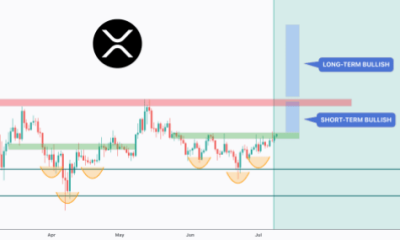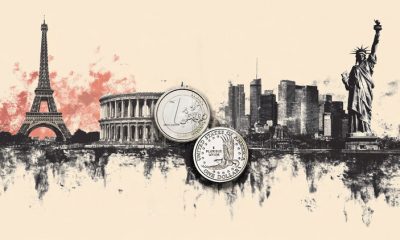

others
USD/INR gains ground, all eyes on RBI MPC meeting – Crypto News
- Indian Rupee loses ground on the renewed US Dollar demand.
- India’s S&P Global Services PMI for November fell to 56.9 vs 58.4 prior, worse than the 58.0 expected.
- The Reserve Bank of India (RBI) is likely to maintain the repo rate unchanged at 6.5% at its December meeting.
Indian Rupee (INR) edges lower on Wednesday on the firmer US Dollar (USD). According to the “Global Credit Outlook 2024” by S&P, India is projected to be the fastest-growing major economy in the next three years. S&P forecast India’s growth of 7% in the 2026–27 fiscal year. Nevertheless, the critical obstacle lies in determining whether the nation can effectively evolve into the next major global manufacturing hub.
On Tuesday, India’s S&P Global Services Purchasing Managers’ Index (PMI) for November came in at 56.9 from 58.4 in October, below the market consensus of 58.0. The figure registered the slowest pace of growth since November 2022, but the index remained firm above the 50-mark threshold that separates growth from contraction.
The Reserve Bank of India (RBI) will schedule its three-day Monetary Policy Committee (MPC) meeting starting on Wednesday. The markets anticipate the central bank will maintain the status quo on the repo rate, leaving it unchanged at 6.5% due to the upbeat GDP growth and the easing trend of core inflation.
Daily Digest Market Movers: Indian Rupee remains sensitive to global factors
- Indian markets are sustaining a rally fueled by an improving interest rate outlook in the US, moderate oil price, resilient domestic macroeconomic data, renewed foreign inflows, and growing optimism about policy continuity in 2024 after the state assembly election results.
- India’s stock market value surpassed $4 trillion for the first time, marking a key milestone for the world’s fifth-biggest equity market.
- S&P Global India Services PMI declined to 56.9 in November from 58.4 in October, below market expectations of 58.0.
- The RBI is likely to sell the US Dollar near 83.38–83.39 levels to cap further depreciation in the Indian Rupee, per Reuters.
- As core CPI inflation moderated to 4.5% YoY and CPI inflation moderated to 4.87% YoY on October 23, analysts anticipate that the RBI will maintain the policy repo rate at its December meeting.
- RBI Governor Shaktikanata Das said that headline inflation has moderated, but the Indian economy remains sensitive to overlapping food price shocks caused by global factors and adverse weather events.
- US ISM Services PMI rose to 52.7 in November from 51.8 in the previous reading, better than the market expectation of 52.0.
- JOLTS Job Openings declined by 617,000 to 8.73M in October, falling to their lowest level since March 2021.
- Fed futures are now pricing that the Fed is done hiking rates and could start cutting policy rates as soon as March or May.
Technical Analysis: Indian Rupee’s positive stance remains in place
Indian Rupee trades weaker on the day. The USD/INR pair has traded within a familiar multi-month-old trading band of 82.80–83.40. Technically, the pair’s outlook remains constructive as it holds above the key 100-day Exponential Moving Average (EMA) on the daily chart. This bullish momentum is reinforced by the 14-day Relative Strength Index (RSI), which remains above the 50.0 midpoint, suggesting that the path of least resistance is to the upside.
The USD/INR first resistance level is located at the upper boundary of the trading range of 83.40. A decisive break above 83.40 could pave the way for a recovery toward the year-to-date (YTD) high of 83.47. Further north, the next hurdle will emerge at a psychological round figure of 84.00.
On the downside, the 83.00 psychological mark is the key support level for the pair. A breach of this level could drag prices toward the confluence of the lower limit of the trading range and a low of September 12 at 82.80, followed by a low of August 11 at 82.60.
US Dollar price today
The table below shows the percentage change of US Dollar (USD) against listed major currencies today. US Dollar was the weakest against the New Zealand Dollar.
| USD | EUR | GBP | CAD | AUD | JPY | NZD | CHF | |
| USD | -0.02% | -0.10% | -0.12% | -0.48% | 0.09% | -0.55% | -0.02% | |
| EUR | 0.02% | -0.08% | -0.11% | -0.45% | 0.10% | -0.52% | 0.00% | |
| GBP | 0.09% | 0.08% | -0.03% | -0.39% | 0.18% | -0.47% | 0.07% | |
| CAD | 0.12% | 0.11% | 0.02% | -0.37% | 0.20% | -0.43% | 0.10% | |
| AUD | 0.49% | 0.47% | 0.40% | 0.36% | 0.57% | -0.05% | 0.48% | |
| JPY | -0.08% | -0.08% | -0.17% | -0.21% | -0.56% | -0.63% | -0.10% | |
| NZD | 0.53% | 0.51% | 0.46% | 0.41% | 0.04% | 0.61% | 0.51% | |
| CHF | 0.01% | 0.00% | -0.07% | -0.10% | -0.44% | 0.10% | -0.52% |
The heat map shows percentage changes of major currencies against each other. The base currency is picked from the left column, while the quote currency is picked from the top row. For example, if you pick the Euro from the left column and move along the horizontal line to the Japanese Yen, the percentage change displayed in the box will represent EUR (base)/JPY (quote).
Indian economy FAQs
The Indian economy has averaged a growth rate of 6.13% between 2006 and 2023, which makes it one of the fastest growing in the world. India’s high growth has attracted a lot of foreign investment. This includes Foreign Direct Investment (FDI) into physical projects and Foreign Indirect Investment (FII) by foreign funds into Indian financial markets. The greater the level of investment, the higher the demand for the Rupee (INR). Fluctuations in Dollar-demand from Indian importers also impact INR.
India has to import a great deal of its Oil and gasoline so the price of Oil can have a direct impact on the Rupee. Oil is mostly traded in US Dollars (USD) on international markets so if the price of Oil rises, aggregate demand for USD increases and Indian importers have to sell more Rupees to meet that demand, which is depreciative for the Rupee.
Inflation has a complex effect on the Rupee. Ultimately it indicates an increase in money supply which reduces the Rupee’s overall value. Yet if it rises above the Reserve Bank of India’s (RBI) 4% target, the RBI will raise interest rates to bring it down by reducing credit. Higher interest rates, especially real rates (the difference between interest rates and inflation) strengthen the Rupee. They make India a more profitable place for international investors to park their money. A fall in inflation can be supportive of the Rupee. At the same time lower interest rates can have a depreciatory effect on the Rupee.
India has run a trade deficit for most of its recent history, indicating its imports outweigh its exports. Since the majority of international trade takes place in US Dollars, there are times – due to seasonal demand or order glut – where the high volume of imports leads to significant US Dollar- demand. During these periods the Rupee can weaken as it is heavily sold to meet the demand for Dollars. When markets experience increased volatility, the demand for US Dollars can also shoot up with a similarly negative effect on the Rupee.
-
![DIS Elliott Wave technical analysis [Video]](https://dripp.zone/news/wp-content/uploads/2025/06/DIS-Elliott-Wave-technical-analysis-Video-Crypto-News-400x240.jpg)
![DIS Elliott Wave technical analysis [Video]](https://dripp.zone/news/wp-content/uploads/2025/06/DIS-Elliott-Wave-technical-analysis-Video-Crypto-News-80x80.jpg) others1 week ago
others1 week agoSkies are clearing for Delta as stock soars 13% on earnings beat – Crypto News
-
![DIS Elliott Wave technical analysis [Video]](https://dripp.zone/news/wp-content/uploads/2025/06/DIS-Elliott-Wave-technical-analysis-Video-Crypto-News-400x240.jpg)
![DIS Elliott Wave technical analysis [Video]](https://dripp.zone/news/wp-content/uploads/2025/06/DIS-Elliott-Wave-technical-analysis-Video-Crypto-News-80x80.jpg) others1 week ago
others1 week agoSkies are clearing for Delta as stock soars 13% on earnings beat – Crypto News
-

 Blockchain1 week ago
Blockchain1 week agoBinance Founder Backs BNB Treasury Company Aiming For US IPO – Crypto News
-

 Blockchain1 week ago
Blockchain1 week agoAnt Group Eyes USDC Integration Circle’s: Report – Crypto News
-

 Blockchain1 week ago
Blockchain1 week agoBitcoin Hits All-Time High as Crypto Legislation Votes Near – Crypto News
-

 Cryptocurrency5 days ago
Cryptocurrency5 days agoWhale Sells $407K TRUMP, Loses $1.37M in Exit – Crypto News
-

 Blockchain1 week ago
Blockchain1 week agoEthereum Bulls Roar — $3K Beckons After 5% Spike – Crypto News
-

 Blockchain1 week ago
Blockchain1 week agoKraken and Backed Expand Tokenized Equities to BNB Chain – Crypto News
-

 others1 week ago
others1 week agoEUR/GBP posts modest gain above 0.8600 ahead of German inflation data – Crypto News
-

 Metaverse1 week ago
Metaverse1 week agoHow Brands Can Deepen Customer Connections in the Metaverse – Crypto News
-

 Cryptocurrency1 week ago
Cryptocurrency1 week agoBitcoin Breaks New Record at $111K, What’s Fueling the $120K Price Target? – Crypto News
-
Technology1 week ago
XRP Eyes $3 Breakout Amid Rising BlackRock ETF Speculation – Crypto News
-
Technology1 week ago
Breaking: SharpLink Purchases 10,000 ETH from Ethereum Foundation, SBET Stock Up 7% – Crypto News
-

 others1 week ago
others1 week agoEUR/GBP climbs as weak UK data fuels BoE rate cut speculation – Crypto News
-
Business1 week ago
PENGU Rallies Over 20% Amid Coinbase’s Pudgy Penguins PFP Frenzy – Crypto News
-

 Blockchain6 days ago
Blockchain6 days agoRobinhood Dealing With Fallout of Tokenized Equities Offering – Crypto News
-
Technology1 week ago
VC Firm Ego Death Capital Closes $100M Funding to Back Bitcoin-Based Projects – Crypto News
-

 Blockchain1 week ago
Blockchain1 week agoAustralia Banks Join Digital Currency Trial for Tokenized Assets – Crypto News
-
Business1 week ago
Did Ripple Really Win XRP Lawsuit Despite $125M Fine? Lawyer Fires Back at CEO – Crypto News
-

 Cryptocurrency1 week ago
Cryptocurrency1 week agoXRP price forecast as coins surges 2.19% to $2.33 – Crypto News
-

 Technology1 week ago
Technology1 week agoPerplexity launches Comet, an AI-powered browser to challenge Google Chrome; OpenAI expected to enter the space soon – Crypto News
-

 Blockchain1 week ago
Blockchain1 week agoSUI Chart Pattern Confirmation Sets $3.89 Price Target – Crypto News
-
Cryptocurrency1 week ago
Tokenized Securities Are Still Securities, US SEC Warns Robinhood, Kraken – Crypto News
-

 others1 week ago
others1 week agoNovaEx Launches with a Security-First Crypto Trading Platform Offering Deep Liquidity and Institutional-Grade Infrastructure – Crypto News
-

 others1 week ago
others1 week agoAnthony Scaramucci Says $180,000 Bitcoin Price Explosion Possible As BTC ‘Supremacy’ Creeps Up – Here’s His Timeline – Crypto News
-

 Cryptocurrency1 week ago
Cryptocurrency1 week agoBitcoin Breaks New Record at $111K, What’s Fueling the $120K Price Target? – Crypto News
-
Business1 week ago
US Senate To Release CLARITY Act Draft Next Week – Crypto News
-

 others1 week ago
others1 week ago$687,220,000 in Bitcoin Shorts Liquidated in Just One Hour As BTC Explodes To $116,000 – Crypto News
-

 Business1 week ago
Business1 week agoS&P Global Downgrades Saks Global’s Credit Rating – Crypto News
-

 Cryptocurrency5 days ago
Cryptocurrency5 days agoSatoshi-Era Bitcoin Whale Moves Another $2.42 Billion, What’s Happening? – Crypto News
-

 Technology1 week ago
Technology1 week ago10 Smartchoice tablets from top brands, curated for everyday use, up to 45% off before Amazon Prime Day Sale – Crypto News
-
others1 week ago
China’s Ant Group With 1.4B Users Taps Circle to Integrate USDC – Crypto News
-

 De-fi1 week ago
De-fi1 week agoOusted Movement Labs Co-Founder Sues Startup in Delaware Court – Crypto News
-

 Technology1 week ago
Technology1 week agoMicrosoft Outlook down: Global outage hit users worldwide, login and mail issues persist – Crypto News
-
Business1 week ago
Breaking: US SEC Delays Grayscale Avalanche ETF Launch – Crypto News
-

 Technology1 week ago
Technology1 week agoOne Tech Tip: Click-to-cancel is over, but there are other ways to unsubscribe – Crypto News
-

 Technology1 week ago
Technology1 week agoGoogle DeepMind hires Windsurf CEO as OpenAI’s $3 billion acquisition collapses – Crypto News
-
Business1 week ago
XRP Set for Big Week as ProShares ETF Launches July 18 – Crypto News
-
Technology1 week ago
Hyperliquid Hits Record $10.6B OI As HYPE Price Records New ATH – Crypto News
-

 Blockchain7 days ago
Blockchain7 days agoZiglu Faces $2.7M Shortfall as Crypto Fintech Enters Special Administration – Crypto News
-

 Cryptocurrency5 days ago
Cryptocurrency5 days agoBitcoin Breaches $120K, Institutional FOMO Takes and House Debate Propel Gains – Crypto News
-

 Blockchain3 days ago
Blockchain3 days agoRipple and Ctrl Alt Team to Support Real Estate Tokenization – Crypto News
-

 others1 week ago
others1 week agoJapanese Yen recovers few pips from two-week low against USD; not out of the woods yet – Crypto News
-

 De-fi1 week ago
De-fi1 week agoLarge-Cap Cryptos Climb as Trump’s Tariff Threats Stir Market Uncertainty – Crypto News
-

 Blockchain1 week ago
Blockchain1 week agoXRP Forms Inverse Head And Shoulders Pattern, Why A Surge To $3.3 Is Possible – Crypto News
-

 Blockchain1 week ago
Blockchain1 week agoBlockchain Can Aid Action Against Criminals – Crypto News
-
Business1 week ago
Reserve Bank of Australia Advances Project Acacia To Test CBDCs, Stablecoins – Crypto News
-

 others1 week ago
others1 week agoUS Government To Add Another $10,000,000,000,000 to National Debt by 2029, According to Prediction Markets – Crypto News
-

 Blockchain1 week ago
Blockchain1 week agoAnt Group Eyes USDC Integration Circle’s: Report – Crypto News
-

 others1 week ago
others1 week agoUSD/INR s as Indian Rupee gains, investors await US-India trade deal confirmation – Crypto News





![The Endgame for fiat currencies [Video]](https://dripp.zone/news/wp-content/uploads/2025/07/The-Endgame-for-fiat-currencies-Video-Crypto-News-400x240.jpg)
![The Endgame for fiat currencies [Video]](https://dripp.zone/news/wp-content/uploads/2025/07/The-Endgame-for-fiat-currencies-Video-Crypto-News-80x80.jpg)





